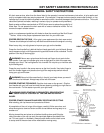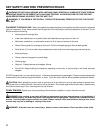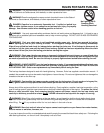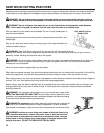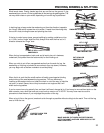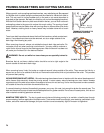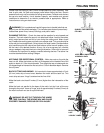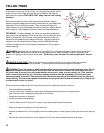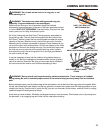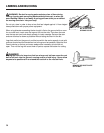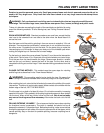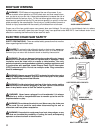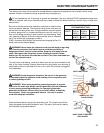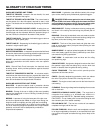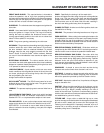
34
GLOSSARY OF CHAIN SAW TERMS
BOW GUIDE - A guide bar (see definition below) with a large
open center used by some professional pulpwood loggers.
DANGER! ECHO warns against the use of a bow guide
on your ECHO chain saw. A bow guide increases the risk of
severe kickback and serious injury. Do not use a bow guide
unless you have experience or specialized training.
BRUSHING OUT - Cutting or otherwise removing undergrowth
and brush in the cutting area and along the planned path of
retreat.
BUCKING - Generally the standard cross cuts made to section
a log or felled tree. Variations include over bucking (cutting from
top down) and under bucking (from underside).
BUMPER - The front of the power head and guide bar cover
used as a work stop and/or pivot point when pivoting the saw
blade into the wood.
BUMPER SPIKE - An optional spiked stop plate for holding the
chain saw steady against the wood, preferred by some chain
saw users during felling operations.
CANT HOOK - A combination hook and lever tool for rolling
and positioning logs.
CHAIN CATCHER - A projection designed to reduce the risk of
the operator’s right hand from being hit by a chain, which has
broken or derailed from the guide bar during cutting.
CHAIN TENSIONER - The device which permits precise
adjustment of the chain tension.
CHAPS - Specially designed leg protection, which can reduce
the risk of injury due to contact with a moving saw chain.
CHOKE - The engine control used to enrich the fuel mixture for
cold starting.
CLEARING - Removing undergrowth and saplings from an area
with a chain saw.
COMPUTED KICKBACK ANGLE (CKA) - The angle that is
computed from testing on a kickback-test machine in
conformance with ANSI B175.1 Standard testing procedures.
FAN COVER - The air intake grille. It covers the cooling fan and
also contains part of the starter assembly.
FELLING BACK CUT - The final cut or series of cuts made to
complete the hinge and fell the tree.
FOLLOW THROUGH - After the chain saw completes a cut and
is no longer supported by the wood, an uncontrolled chain saw
can continue on its path and strike the legs, feet or body of the
operator.
GASOLINE POWERED UNIT TERMS
THROTTLE TRIGGER - Located in the rear handle, it is used
to control the speed of the engine.
THROTTLE TRIGGER LATCH BUTTON - The control used to
set the throttle for a fast idle speed, required to start a cold
engine. The throttle can be unlatched by squeezing the throttle
trigger.
THROTTLE TRIGGER LOCKOUT LEVER - A safety lever on
the top of the rear handle which must be depressed before the
throttle trigger can be activated. When the operator lets go of
the rear handle, the throttle will be locked in idle position.
THROTTLING BACK - Releasing the throttle trigger to allow a
decrease in engine speed (rpm).
THROTTLING UP - Depressing the throttle trigger to allow an
increase in engine speed (rpm).
ELECTRIC POWERED UNIT TERMS
DIELECTRIC MATERIAL - A material that reduces the likelihood
of shock or electrocution by providing protection against current
flow through the chain saw housing to the operator.
GAUGE - a term that is used to describe the size of wire required
when using extension cord with electric units over specific
distances.
GFCI - Ground Fault Circuit Interrupter. An electrical circuit
breaking device which provides protection against electrical
shock hazards.
THROTTLE TRIGGER/STOP SWITCH - An electrical switch,
which allows the motor to start and run, prevents the motor from
running, and turns the motor off. Refer to Operator’s Manual to
learn and understand the stop and start Procedure.
GASOLINE AND ELECTRIC UNIT TERMS
BALLISTIC - A special material used in protection devices
designed to reduce the risk of penetration from chain contact.
BINDING - Closing of the cut or shifting of the wood, possibly
trapping the saw blade in the cut. Binding includes pinching.
(Also, see PINCH.)
BORING - A process of using the lower part of the bar nose
and chain to penetrate the middle of a log or tree. Boring can
keep the wood from splitting and the guide bar from binding
as the cut is continued either up or down from the middle. But
this is an extremely dangerous operation with a high kickback
potential, and should not be attempted by untrained or
inexperienced operators.



